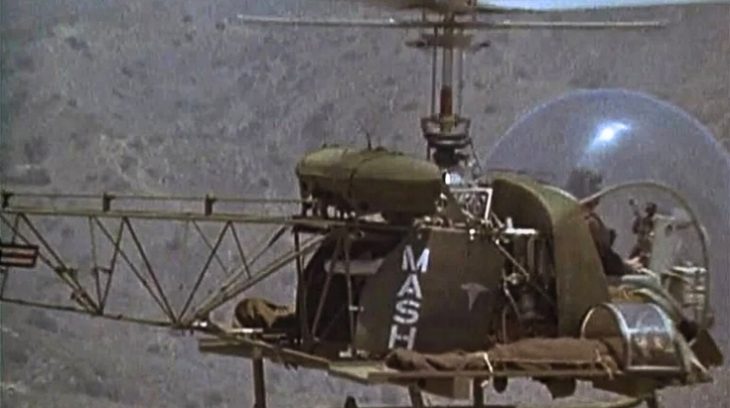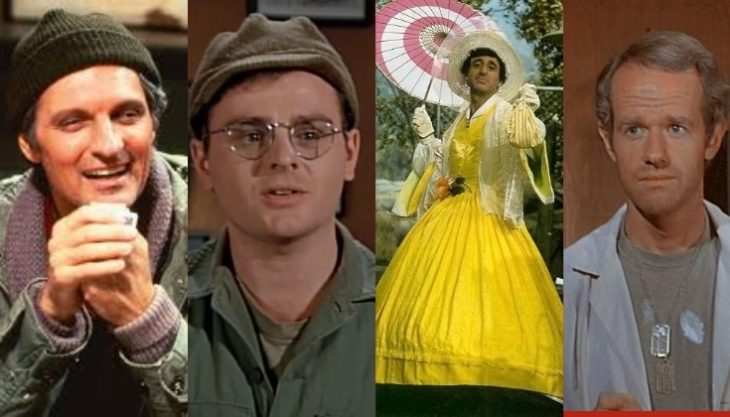When you think of the opening credits of MASH, what do you picture? I picture the helicopters. That familiar bubble canopy, together with the theme song, lets me know I’m about to spend some time with old friends. But, how accurate are the helicopters? Were these the same type that were actually used in the Korean War to transport wounded soldiers from the front lines to MASH units? Yes! The helicopter you see on MASH is the Bell H-13 Sioux. The sight and sound of this aircraft would have been a comforting and welcome thing for soldiers. While the Bell H-13 isn’t the only helicopter that was used, its prominence in the show is entirely accurate.

While helicopters had been used to evacuate wounded during combat situations, including during WWII, the Korean War greatly expanded their use. Retrieving wounded from behind enemy lines so that they could quickly be transported to MASH units close to the front had never been done on such a scale. The small and agile helicopters used during the war saved many lives. Without these aircraft, thousands of young men would have lost their lives. While the Bell H-13, immortalized in MASH, was the primary air ambulance, other helicopters were also used, including the Sikorsky H-5 Dragonfly, the Hiller H-23 Raven, the Sikorsky HO5S-1, and others.

Bell H-13 Helicopter (Used On MASH)
One of the most popular and well-used light helicopters ever built, the Bell H-13 Sioux was a single-engine, single-rotor helicopter that could accommodate a pilot, one passenger, and two stretchers, mounted on the skids. Its top speed was 85 mph with a range of 200 miles, cruising at 70mph. Its top altitude was 13,000 feet. Although I’m not sure, I believe there may have been some improved versions with a higher top speed, range, and height. The Army first began acquiring these helicopters in 1946 (initially called the Bell 47).
The Bell H-13 was such a familiar part of the Korean war that it became known as the “Angel of Mercy.” More than one MASH episode centers on the heroics of the pilots who flew these aircraft, and this was no exaggeration. One pilot evacuated 922 casualties, flying over 545 missions in just 14 months! This was over 700 hours of total flight time.

The Helicopters Used to Film MASH
There were, as far as I know, two Bell H-13 helicopters used to film MASH. One of them was used more than the other, appearing in over 263 episodes. The opening credits scene used three helicopters; only one of them was off-screen, carrying the camera to film the others.
If you look for pictures of the Bell H-13 (Bell Model 47), you may be confused and even think this article is inaccurate. They don’t always look alike! The helicopters you see in the show may not perfectly match other H-13 helicopters you find in images. Bell called every piston-powered helicopter they made a Model 47. While you’ll often see the bubble canopy that earned it the nickname “flying fishbowl” and the light skeletal framework, the appearance of individual aircraft could vary quite a lot.
The Real Pilot of the MASH Helicopters
Obviously, the actors who portrayed pilots on MASH were not really flying the helicopters. The principal pilot who flew the main helicopter was Captain E. Ray Poss, Jr. He owned and operated the main Bell 47 helicopter used in most episodes. Poss has written a memoir called One Helicopter Pilot’s Experience.
Poss never appeared in the credits but was visible in many scenes, both on the helipad and flying overhead. He also had a line of dialogue in Season 3, Episode 11, Adam’s Ribs. He never received fair pay due to a long-running dispute with the Screen Actors’ Guild, but eventually he received residual payments.
Smilin’ Jack MASH Episode – Pilot of the Year
Season 4, Episode 22, titled Smilin’ Jack, featured a pilot, Lt. Jack Mitchell, who was trying to set a record for the number of wounded transported before being grounded because of his diabetes. If he could beat the record, he would become “Chopper Pilot of the Year.” After bringing in one wounded soldier, Lt. Mitchell tells Hawkeye that his tally is up to 839. However, his chief competition, Dangerous Dan, has 842, meaning Smilin’ Jack only needs to transport 4 more wounded to win. While these numbers are completely within the realm of possibility, Mitchell’s heroic feat at the end of the episode, where he transports 4 people, two in the cockpit with himself, and two more in the litters, is probably impossible. It would have well exceeded the capacity of the Bell H-13.
Inaccurate Or Anachronistic Helicopters
While the helicopters seen transporting wounded in MASH were entirely accurate to what was used in the Korean War, there were a few instances of inaccurate helicopters being depicted. In two early episodes of the second season, For the Good of the Outfit (4), and Kim (6), a model of a helicopter can be seen hanging from the ceiling in Henry’s office. According to Larry Gelbart, this model of a Bell UH-1 Iroquois or “Huey” was made by his son. These helicopters were used extensively during the Vietnam War. The model was removed after it was determined that its presence was during the Korean War was anachronistic, as they were not flown until 1956.
A similar helicopter is seen on a poster in the Officers’ Club that appears in many episodes. This may also be a Huey helicopter. The poster reads 4077th MED CO AIR AMBULANCE. If the written text on the poster refers to the 45th Medical Company “Air Ambulance,” this is also anachronistic, as the unit, then designated the 45th Medical Collecting Company, never actually deployed to Korea.
Here is a list of other inaccurate helicopters that appeared on MASH from time to time.
Season 1, Pilot Episode: Henry Blake and Scorch leave for Seoul in a helicopter that was not introduced until 1956. It’s not too far off but it’s definitely an anachronism The helicopter was a Bell 47J. This was a later variation of the Bell Model 47 that, as I’ve explained, was the main transport helicopter used for wounded in the show and during the Korean War. This helicopter had a larger enclosed cockpit with seats in the back for 3 passengers, and an enclosed tail boom, (known in the military as the Bell UH-13J) had an enclosed tail boom and a larger enclosed cabin with a pilot in front and a second row of seats behind for 3 passengers, and the tail boom was enclosed rather than open. Keep in mind that there were always many different variations and models of helicopters and, this far after the Korean War, it would be hard to always get them right! As it stands, this is not a big deal.
Season 1, Episode 9, Henry, Please Come Home: Henry has been reassigned to Tokyo after receiving a citation for the 4077th’s outstanding performance. Frank takes over command and does what Frank does, trying to turn the unit into a military camp. He then dismantles and confiscates Hawkeye and Trapper’s still. This is more than they can take so they forge passes to go to Tokyo to convince Henry to come home. To do so, they pretend that Radar is very sick. The helicopter Henry uses to rush back to the 4077 is a French Aérospatiale Alouette II. This helicopter was introduced in 1955. Not only that, it wwas never used by any U.S. military forces.






